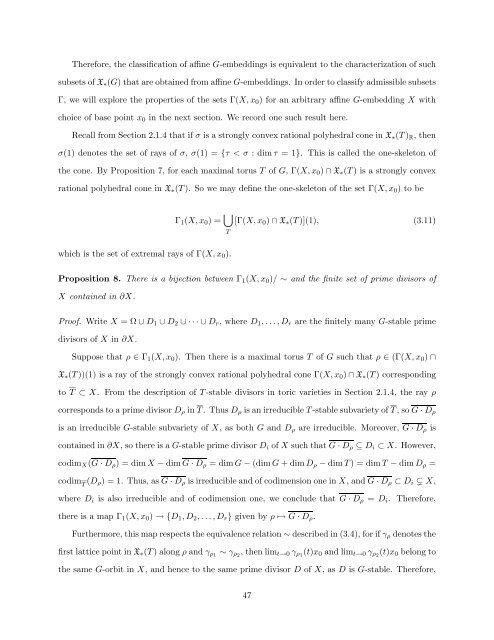Equivariant Embeddings of Algebraic Groups
Equivariant Embeddings of Algebraic Groups
Equivariant Embeddings of Algebraic Groups
Create successful ePaper yourself
Turn your PDF publications into a flip-book with our unique Google optimized e-Paper software.
Therefore, the classification <strong>of</strong> affine G-embeddings is equivalent to the characterization <strong>of</strong> such<br />
subsets <strong>of</strong> X ∗ (G) that are obtained from affine G-embeddings. In order to classify admissible subsets<br />
Γ, we will explore the properties <strong>of</strong> the sets Γ(X, x 0 ) for an arbitrary affine G-embedding X with<br />
choice <strong>of</strong> base point x 0 in the next section. We record one such result here.<br />
Recall from Section 2.1.4 that if σ is a strongly convex rational polyhedral cone in X ∗ (T ) R , then<br />
σ(1) denotes the set <strong>of</strong> rays <strong>of</strong> σ, σ(1) = {τ < σ : dim τ = 1}. This is called the one-skeleton <strong>of</strong><br />
the cone. By Proposition 7, for each maximal torus T <strong>of</strong> G, Γ(X, x 0 ) ∩ X ∗ (T ) is a strongly convex<br />
rational polyhedral cone in X ∗ (T ). So we may define the one-skeleton <strong>of</strong> the set Γ(X, x 0 ) to be<br />
Γ 1 (X, x 0 ) = ⋃ T<br />
[Γ(X, x 0 ) ∩ X ∗ (T )](1), (3.11)<br />
which is the set <strong>of</strong> extremal rays <strong>of</strong> Γ(X, x 0 ).<br />
Proposition 8. There is a bijection between Γ 1 (X, x 0 )/ ∼ and the finite set <strong>of</strong> prime divisors <strong>of</strong><br />
X contained in ∂X.<br />
Pro<strong>of</strong>. Write X = Ω ∪ D 1 ∪ D 2 ∪ · · · ∪ D r , where D 1 , . . . , D r are the finitely many G-stable prime<br />
divisors <strong>of</strong> X in ∂X.<br />
Suppose that ρ ∈ Γ 1 (X, x 0 ). Then there is a maximal torus T <strong>of</strong> G such that ρ ∈ (Γ(X, x 0 ) ∩<br />
X ∗ (T ))(1) is a ray <strong>of</strong> the strongly convex rational polyhedral cone Γ(X, x 0 ) ∩ X ∗ (T ) corresponding<br />
to T ⊂ X. From the description <strong>of</strong> T -stable divisors in toric varieties in Section 2.1.4, the ray ρ<br />
corresponds to a prime divisor D ρ in T . Thus D ρ is an irreducible T -stable subvariety <strong>of</strong> T , so G · D ρ<br />
is an irreducible G-stable subvariety <strong>of</strong> X, as both G and D ρ are irreducible. Moreover, G · D ρ is<br />
contained in ∂X, so there is a G-stable prime divisor D i <strong>of</strong> X such that G · D ρ ⊆ D i ⊂ X. However,<br />
codim X (G · D ρ ) = dim X − dim G · D ρ = dim G − (dim G + dim D ρ − dim T ) = dim T − dim D ρ =<br />
codim T<br />
(D ρ ) = 1. Thus, as G · D ρ is irreducible and <strong>of</strong> codimension one in X, and G · D ρ ⊂ D i X,<br />
where D i is also irreducible and <strong>of</strong> codimension one, we conclude that G · D ρ = D i . Therefore,<br />
there is a map Γ 1 (X, x 0 ) → {D 1 , D 2 , . . . , D r } given by ρ ↦→ G · D ρ .<br />
Furthermore, this map respects the equivalence relation ∼ described in (3.4), for if γ ρ denotes the<br />
first lattice point in X ∗ (T ) along ρ and γ ρ1 ∼ γ ρ2 , then lim t→0 γ ρ1 (t)x 0 and lim t→0 γ ρ2 (t)x 0 belong to<br />
the same G-orbit in X, and hence to the same prime divisor D <strong>of</strong> X, as D is G-stable. Therefore,<br />
47
















